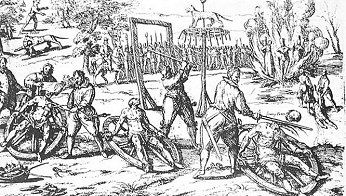 The year was 1589, in the German village of Bedburg. This was a time when superstition and religion ruled supreme in people’s lives. Many things that we consider common today were considered ghastly in those times. That is why the alleged crimes and the trial that followed must have been unimaginable for folks living in the time of The Werewolf of Bedburg.
The year was 1589, in the German village of Bedburg. This was a time when superstition and religion ruled supreme in people’s lives. Many things that we consider common today were considered ghastly in those times. That is why the alleged crimes and the trial that followed must have been unimaginable for folks living in the time of The Werewolf of Bedburg.
For years the local townsfolk had been tormented by something that they could only describe as a demon. Their livestock and even children had become the victim of something horrible. Throats were ripped out and flesh was eaten away from the unfortunate victims. The beast that lingered in the forest had left a trail of blood and misery in it’s wake. Witnesses reported a wolf like beast as being responsible for the grisly attacks. Villagers were afraid to travel and even neglected necessary chores in fear of the creature.
It wasn’t long until hunting parties were organized in attempt to kill the lycan beast. One night in 1589 a group of hunters cornered what was described as a hairy wolf like animal. After attempts to stab it with spears and dogs were released upon it, something strange happened. The creature stood up. Suddenly the hunters realized that the beast was none other than Peter Stubbe, a local citizen.
Stubbe was arrested and the trial that followed revealed grotesque accounts that ended with the execution of Stubbe on Halloween night of 1589. It was learned in the trial that Stubbe had been responsible for at least sixteen deaths of men women and children. He was charged with rape, murder, cannibalism and even confessed to eating the brains of his own son.
at least sixteen deaths of men women and children. He was charged with rape, murder, cannibalism and even confessed to eating the brains of his own son.
Stubbe confessed to practicing sorcery and witchcraft since the age of twelve. He claimed that he had indeed made a pact with the devil and was given the powers of the wolf. He admitted to stalking and devouring livestock in the area for many years. He confessed that Satan had given him a magic belt that when put on, caused his transformation into the wolf. He described how he would chase down young girls who had been in the fields like a swift hound and upon catching the slowest one, would devour their flesh (among other things).
Stubbe was accused of many more unspeakable crimes and was eventually given one of the most brutal and grisly punishments in history. Most of the information about the incident has only been available because of an ancient pamphlet that described the crimes and trial. But it was written that The Werewolf of Bedburg had his skin torn from his body, his arms and legs broken and head severed. He was eventually burned to ash, but only after a monument was built as a warning to any others that may walk in the shadow of the wolf. His head was placed on top of It.
It is important to mention that the confessions of Peter Stubbe took place while on the torture wheel and enduring unimaginable pain. Much like the Salem Witch Trials, the accused would often confess to anything during this type of torture. But the villagers seemed convinced enough to dub Peter Stubbe “The Werewolf of Bedburg” and forever place him in history as the Real Wolfman.
Many have attributed the Werewolf of Bedburg incident as what spawned many future tales and legends of werewolves. Some have even stated that Stubbe could have suffered from an actual mental condition known as clinical lycanthropy in which the person believes that he or she is an animal and behaves as such. Some cases have even reported the sufferers of this mental illness to grow excessive hair in a response to the condition. It is known that the mind has a powerful affect on the body. But was Peter Stubbe the victim of a mental illness? Or was he truly a werewolf as a result of his witchcraft and pacts with the devil? Some say that he was neither and merely the victim of an overly superstitious time in history. If the latter is true, then what did slaughter those people in the forests and fields of Bedburg, Germany? We may never know, but the legend of the werewolf will most likely live in the subconscious fears of humanity forever.

